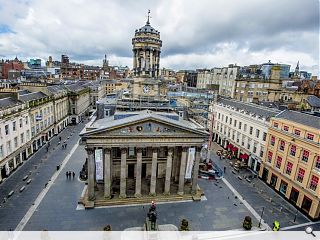Prominent Glasgow clock tower restored
July 4 2016
Austin-Smith:Lord have completed a clean, restoration and reinstatement of a 189 year old clock tower at Glasgow’s Gallery of Modern Art, Queen Street, on behalf of Glasgow Life and Historic Environment Scotland.A comprehensive conservation plan saw layers of cream paint, weeds and cement repairs stripped off to reveal the fine Corinthinan columns buried beneath.
City Building Group and CBC Stone carried out the work which included redecorating the clock face, as well as undoing ‘serious errors’ in the original construction which included re-bedding incorrectly placed stones.
David Millar, director and head of conservation at Austin-Smith:Lord, added: “This has been a very interesting and challenging project, assessing solutions and actions that would both enhance the visual aesthetic of this landmark, but also ensure an improved lifespan of the masonry structure into the future.
“There is always a level of risk associated with removing paint from sandstone but it’s an exciting activity as you don’t know what you might find! We discovered masonry wrongly bedded and sandstone heavily carbonated and although some individuals might like to see these dark deposits removed, it’s not good practice as you are potentially removing too much original historic and listed fabric.”
The Royal Exchange Square property was originally built as a townhouse for tobacco merchant William Cunningame of Lainshaw in 1778 before being enlarged in 1817 to form a bank when the Queen Street frontage, cupola and clock tower were added.
3 Comments
#2 Posted by basho on 5 Jul 2016 at 14:00 PM
Sift through the strained faux Scoattush vernacular of Big Chantelle (who I suspect is an old Fettesian and works in hedge fund management) and there is occasionally a good point to be found.
Who do they leave so much stonework uncleaned? They do the same in Edinburgh. It's not preserving character. It's making the building look worse. As BC points out - it looks like some unfortunate skin condition. Either clean the whole exterior or leave it alone.
Who do they leave so much stonework uncleaned? They do the same in Edinburgh. It's not preserving character. It's making the building look worse. As BC points out - it looks like some unfortunate skin condition. Either clean the whole exterior or leave it alone.
#3 Posted by Terra on 6 Jul 2016 at 02:30 AM
From what I gather the original construction wasn't the best and the subsequent additions of paint etc had done a fair bit of damage. It seems they did the best they could and the contrast will disappear over time.
Fair enough for me. The stone couldn't breath with that horrid paint that was on it before, now it can. It may be a bit "patchwork" but it won't be permanent and it's better than allowing further degradation.
Of course it would have been preferable to be able to simply clean it and bobs-your-uncle but that wasn't an option.
Well done to them for doing their best to preserve a quite stunning part of a quite stunning building.
Fair enough for me. The stone couldn't breath with that horrid paint that was on it before, now it can. It may be a bit "patchwork" but it won't be permanent and it's better than allowing further degradation.
Of course it would have been preferable to be able to simply clean it and bobs-your-uncle but that wasn't an option.
Well done to them for doing their best to preserve a quite stunning part of a quite stunning building.
Post your comments
Read previous: Paisley chemical plant flattened for 500 homes
Back to July 2016
Like us on Facebook
Become a fan and share
News Archive
Search News
Features & Reports
For more information from the industry visit our Features & Reports section.




Am sick ae hearing fae all these so cawwed 'conservationists' about how the dirt an soot oan the buildings is part ae thur character. It isnae. Exhaust fumes fae a rusty Ford Mondeo which has oor the years made the building dirty isnae character.Natural weathering is howwer.
Wid ye leave yer best clayse wae dirty marks oan them fur the character? Naw, yed wash them.
It's these wee details which hawd the building's potenshul back.
A mean, the toap ae this museum now looks like it's goat Vitiligo.